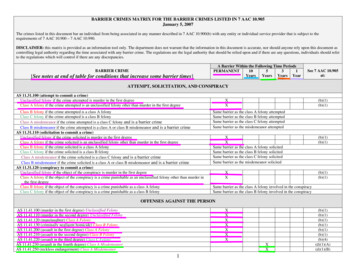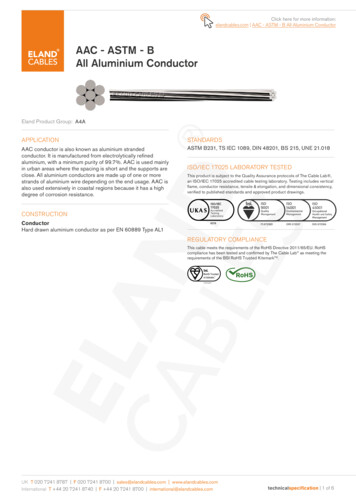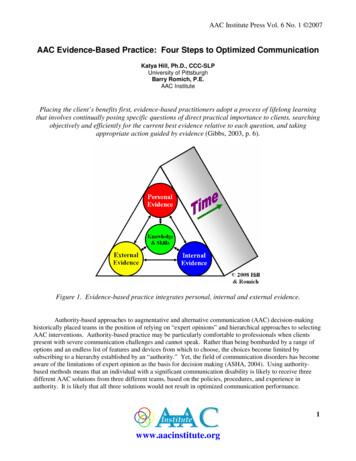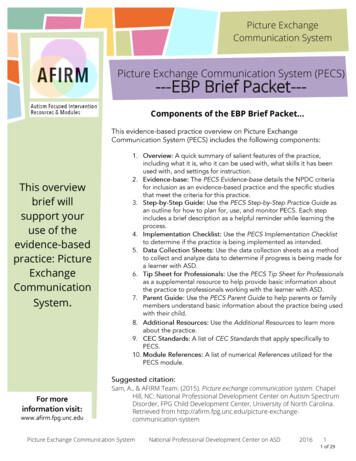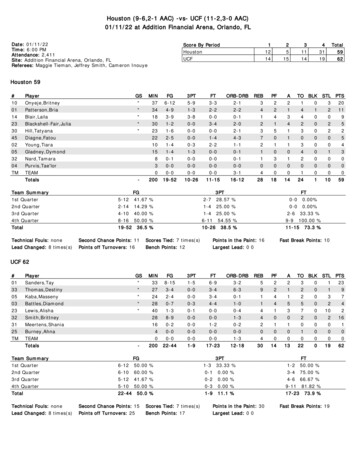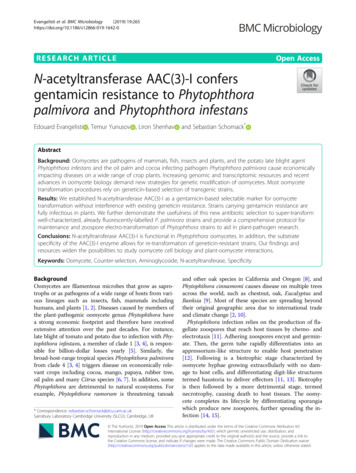
Transcription
Evangelisti et al. BMC Microbiology(2019) EARCH ARTICLEOpen AccessN-acetyltransferase AAC(3)-I confersgentamicin resistance to Phytophthorapalmivora and Phytophthora infestansEdouard Evangelisti , Temur Yunusov , Liron Shenhavand Sebastian Schornack*AbstractBackground: Oomycetes are pathogens of mammals, fish, insects and plants, and the potato late blight agentPhytophthora infestans and the oil palm and cocoa infecting pathogen Phytophthora palmivora cause economicallyimpacting diseases on a wide range of crop plants. Increasing genomic and transcriptomic resources and recentadvances in oomycete biology demand new strategies for genetic modification of oomycetes. Most oomycetetransformation procedures rely on geneticin-based selection of transgenic strains.Results: We established N-acetyltransferase AAC(3)-I as a gentamicin-based selectable marker for oomycetetransformation without interference with existing geneticin resistance. Strains carrying gentamicin resistance arefully infectious in plants. We further demonstrate the usefulness of this new antibiotic selection to super-transformwell-characterized, already fluorescently-labelled P. palmivora strains and provide a comprehensive protocol formaintenance and zoospore electro-transformation of Phytophthora strains to aid in plant-pathogen research.Conclusions: N-acetyltransferase AAC(3)-I is functional in Phytophthora oomycetes. In addition, the substratespecificity of the AAC(3)-I enzyme allows for re-transformation of geneticin-resistant strains. Our findings andresources widen the possibilities to study oomycete cell biology and plant-oomycete interactions.Keywords: Oomycete, Counter-selection, Aminoglycoside, N-acetyltransferase, SpecificityBackgroundOomycetes are filamentous microbes that grow as saprotrophs or as pathogens of a wide range of hosts from various lineages such as insects, fish, mammals includinghumans, and plants [1, 2]. Diseases caused by members ofthe plant-pathogenic oomycete genus Phytophthora havea strong economic footprint and therefore have receivedextensive attention over the past decades. For instance,late blight of tomato and potato due to infection with Phytophthora infestans, a member of clade 1 [3, 4], is responsible for billion-dollar losses yearly [5]. Similarly, thebroad-host-range tropical species Phytophthora palmivorafrom clade 4 [3, 4] triggers disease on economically relevant crops including cocoa, mango, papaya, rubber tree,oil palm and many Citrus species [6, 7]. In addition, somePhytophthora are detrimental to natural ecosystems. Forexample, Phytophthora ramorum is threatening tanoak* Correspondence: sebastian.schornack@slcu.cam.ac.ukSainsbury Laboratory Cambridge University (SLCU), Cambridge, UKand other oak species in California and Oregon [8], andPhytophthora cinnamomi causes disease on multiple treesacross the world, such as chestnut, oak, Eucalyptus andBanksia [9]. Most of these species are spreading beyondtheir original geographic area due to international tradeand climate change [2, 10].Phytophthora infection relies on the production of flagellate zoospores that reach host tissues by chemo- andelectrotaxis [11]. Adhering zoospores encyst and germinate. Then, the germ tube rapidly differentiates into anappressorium-like structure to enable host penetration[12]. Following is a biotrophic stage characterized byoomycete hyphae growing extracellularly with no damage to host cells, and differentiating digit-like structurestermed haustoria to deliver effectors [11, 13]. Biotrophyis then followed by a more detrimental stage, termednecrotrophy, causing death to host tissues. The oomycete completes its lifecycle by differentiating sporangiawhich produce new zoospores, further spreading the infection [14, 15]. The Author(s). 2019 Open Access This article is distributed under the terms of the Creative Commons Attribution 4.0International License (http://creativecommons.org/licenses/by/4.0/), which permits unrestricted use, distribution, andreproduction in any medium, provided you give appropriate credit to the original author(s) and the source, provide a link tothe Creative Commons license, and indicate if changes were made. The Creative Commons Public Domain Dedication o/1.0/) applies to the data made available in this article, unless otherwise stated.
Evangelisti et al. BMC Microbiology(2019) 19:265Genomic [16–18], transcriptomic [15, 19], proteomicand metabolomic [20, 21] resources have been obtained tohelp deciphering the molecular basis of oomycete virulence. Genetic manipulation of oomycetes has gained increasing interest with the study of their molecularweaponry and the modalities of host tissue colonization[22–26]. At least four methods have been successfully applied to transform oomycetes: liposome-mediated protoplast transformation [27], microprojectile bombardment[28], Agrobacterium-mediated transformation [29, 30] andelectroporation [31]. By contrast, only a handful of vectorsare commonly used for delivery and genomic integrationof transgenes in oomycetes. Most of them carry the Bremialactucae Ham34 constitutive promoter [32] and nativepromoters are rarely used [25, 33]. The selection of oomycete transformants relies on the aminoglycoside antibioticsgeneticin (G418) or hygromycin B [27].Aminoglycosides antibiotics are synthesized by bacteria from the genera Streptomyces and Micromonospora[34]. They bind to the prokaryotic ribosomal decodingsite, thereby reducing the fidelity of protein synthesisand ultimately killing susceptible bacteria [35]. The isolation of aminoglycoside-inactivating enzymes has widened their usage in basic research to assist with bacterialtransformation. In addition, some antibiotic/enzymecombinations have been successfully used for the selection of transfected eukaryotic cells [36, 37]. Enzymaticinactivation of aminoglycosides can be achieved throughacetylation, adenylylation, and phosphorylation [38] andseveral enzyme classes exist for each of these modifications. For instance, four classes of N-acetyltransferasesinactivate aminoglycosides by acetylation of the 1-, 3-,2′- and 6′-amino groups, respectively, conferring partially overlapping aminoglycoside resistance profiles [38].Here we demonstrate that the aminoglycoside gentamicin arrests P. palmivora and P. infestans growth in vitro.The N-acetyltransferase AAC(3)-I confers gentamicin resistance, but retains geneticin (G418) susceptibility in P.palmivora. We generated Gateway compatible pTOR vectors for gentamicin-based selection to super-transformG418-resistant P. palmivora. This enabled fluorescent labelling of multiple cellular compartments and structures.Our findings and materials extend antibiotic selection aswell as genetic manipulation possibilities for oomycetes.Page 2 of 8palmivora and P. infestans were both susceptible to gentamicin (Fig. 1). A concentration of 10 mg/L gentamicin(Fig. 1a) limited P. infestans hyphal growth and inhibitedsporangia formation. By contrast, some P. palmivora colonies were still able to grow and produce sporangia at thisconcentration (Fig. 1b). At 100 mg/L gentamicin, development of both oomycete species was fully arrested at thegerminating cyst stage (Fig. 1a-b). Thus, gentamicin-100 isa robust and reproducible inhibitor of mycelial growth onV8 and RSA agar growth media.Gentamicin is a reliable selectable marker for P. palmivoraTo determine whether gentamicin-based selection couldbe used on G418-resistant Phytophthora, we assessedgrowth of transgenic P. palmivora and P. infestansstrains carrying the neomycin phosphotransferase (nptII)resistance gene on vegetable V8 juice agar plates containing 100 mg/L gentamicin (Fig. 2a-b). We found thatthe growth of transgenic P. infestans (Fig. 2a) and P. palmivora (Fig. 2b) strains expressing tdTomato was impaired on selective plates containing gentamicin. Thus,the nptII gene does not confer resistance to gentamicin.To determine whether gentamicin can be used as a selectable marker for P. palmivora, we generated a set ofpTOR-Gateway vectors carrying the aminoglycoside 3-Nacetyltransferase I (aac(3)-I or aacC1) gene from Pseudomonas aeruginosa [39] as a replacement for nptII (Additional file 1: Table S1). Using an improved electroporationapproach (Supporting Protocol), we transformed the wildtype P. palmivora strain LILI with a pTORGm43GW vector carrying a construct for constitutive expression of anactin-labelling Lifeact:mCitrine reporter under control ofthe Ham34 promoter. Transformants grew on V8 mediumcontaining gentamicin (Fig. 2c), suggesting that Hsp70prodriven aacC1 expression efficiently detoxified gentamicin.Furthermore, the growth of gentamicin-resistant P. palmivora strains on V8 plates supplemented with G418 was attenuated (Fig. 2c), confirming that aacC1 does not confercross-resistance to G418. In addition, gentamicin-resistantP. palmivora strains were able to infect Nicotianabenthamiana leaves and formed intracellular haustoria (Fig.2d), suggesting that expression of the AAC (3)-I enzymedoes not impair the virulence of these strains. Takentogether, gentamicin is a reliable selectable marker forP. palmivora.ResultsGentamicin inhibits P. palmivora and P. infestans growthin vitroGentamicin-based vectors for super-transformation ofG418-resistant Phytophthora strainsTo expand the possibilities for antibiotic selection aftertransformation we surveyed P. infestans and P. palmivorafor their susceptibility to carbenicillin, chloramphenicol,cefotaxime, gentamicin, rifampicin, spectinomycin andtetracycline. While most antibiotics were not effective inlimiting mycelial growth (Additional file 1: Figure S1), P.Next, we assessed the possibility to perform dual selection using both G418 and gentamicin (Fig. 3). To thatend, we transformed the G418-resistant P. palmivoraLILI-YKDEL strain [15, 40] with vectors carrying theaacC1 gene in addition to a construct for constitutiveexpression of either an actin-labelling Lifeact:mScarlet-I
Evangelisti et al. BMC Microbiology(2019) 19:265Page 3 of 8Fig. 1 Gentamicin impairs growth of wild-type and G418-resistant Phytophthora palmivora and Phytophthora infestans strains in vitro. a-b)Representative pictures of 5-day-old P. palmivora LILI (accession P16830) grown on V8 (a) or 10-day-old P. infestans isolate 88,069 grown on RSA(b). Plates were supplemented with 0, 10, 25, 50 or 100 mg/L gentamicin. Scale bar is 30 μmfluorescent reporter (Fig. 3a-b) or a cytoplasmic tdTomato and a nuclear-localized mTFP1 fluorescent protein(Fig. 3c-d). All regenerated transformants were able togrow on V8 medium containing both G418 and gentamicin and expressed the different reporter genes in theirrespective subhyphal compartments (Fig. 3b, d). Hence,pTOR-Gateway vectors carrying a gentamicin resistancecassette allow for super-transformation of G418resistant transgenic P. palmivora strains.DiscussionHere we document that gentamicin is a robust selectablemarker for P. palmivora that can be used for transformation of wild-type and G418-resistant strains. Many aminoglycosides are primarily used as bactericidal antibiotics.They inhibit protein synthesis by binding to the A-site onthe 16S ribosomal RNA of the 30S bacterial ribosome [41,42]. Besides its activity in prokaryotes, gentamicin selection was used as an efficient selectable marker ineukaryotic plants such as Petunia hybrida [43] and Nicotiana tabacum [44]. Efficient gentamicin-based selectionwas also reported for Arabidopsis thaliana [43] and, morerecently, for the liverwort Marchantia polymorpha [45],although no mechanism of action has been proposed sofar. In addition, a bifunctional enzyme conferring resistance to both gentamicin and tobramycin was used forselection of N. tabacum transplastomic lines [46], takingbenefit of the prokaryotic translational apparatus ofchloroplasts [47]. The low affinity of aminoglycosides foreukaryotic ribosomes is due to differences at two key nucleotides of the ribosomal RNA that occupy the ribosomedecoding centre [48, 49]. However, a few aminoglycosidesbind to eukaryotic ribosomes are thus are used in nonsense suppression therapy to suppress translation termination at in-frame premature termination codons [50].Whether gentamicin binds to oomycete ribosomes ormitochondrial ribosomes (mitoribosomes) remain to bedetermined. Indeed, studies of hybrid bacterial ribosomescontaining a decoding site mimicking the human mitochondrial 12S rRNA showed altered protein translation fidelity in the presence of aminoglycosides, suggestingaminoglycosides can interfere with mitoribosomes function [51]. In addition, gentamicin may interfere with otherkey metabolic processes. For instance, some reports suggest that gentamicin may suppress the ADP ribosylationfactor (ARF)-dependent protein trafficking [52].We found that the nptII selectable marker expressed byG418-resistant P. palmivora strains does not confer resistance to gentamicin, and that growth of P. palmivora strainscarrying the aacC1 selectable marker was arrested on V8plates containing G418, but not gentamicin. Our data areconsistent with the specificity of these aminoglycoside
Evangelisti et al. BMC Microbiology(2019) 19:265Page 4 of 8Fig. 2 Gentamicin is a reliable selectable marker for Phytophthora (a-b) Representative pictures of 5-day-old transgenic P. palmivora LILI (c) or 10day-old transgenic P. infestans (d) carrying a construct for constitutive expression of the tdTomato fluorescent protein. Plates were grown on V8or RSA, respectively, and supplemented or not with 100 mg/L gentamicin. c Representative pictures of 5-day-old transgenic P. palmivora LILItransformed with a gentamicin-based pTOR vector, grown on V8 plates containing either no antibiotic (left), 100 mg/L gentamicin (middle) or100 mg/L geneticin (G418, right). d Representative pictures of infectious hyphae from a gentamicin-resistant P. palmivora strain expressing aconstitutive Lifeact:mCitrine reporter, 24 h after infection of a Nicotiana benthamiana leaf. Arrowheads indicate haustoria. Scale bar is 10 μmprocessing enzymes. The gene aacC1 [39] used in ASE I (AAC(3)-I), which has narrowsubstrate specificity and can only acetylate gentamicin,astromicin and sisomicin [38]. The nptII gene derived fromthe Tn5 transposon encodes the AMINOGLYCOSIDE 3′PHOSPHOTRANSFERASE II (APH(3′)-II) which canphosphorylate kanamycin, G418 and gentamicin B, but notmembers of the gentamicin C complex [38]. Gentamicin Cconstitutes 80% of the gentamicin sulphate preparations[53] and has more potent antimicrobial activity than theremaining 20% of so-called minor components (mostlygentamicins A, B and X) [54]. Considering substrate specificities of the APH(3′)-II and AAC(3)-I enzymes and composition of the gentamicin antibiotic was crucial for thesuccess of double selection approaches in this study.
Evangelisti et al. BMC Microbiology(2019) 19:265Page 5 of 8Fig. 3 Gentamicin-based pTOR vectors enable super-transformation of G418-resistant P. palmivora strains. a A transgenic P. palmivora LILI-YKDELstrain was transformed with a gentamicin-based vector carrying a construct for constitutive expression of a Lifeact:mScarlet-I reporter. b Representativepictures of hyphae grown axenically on V8 plate containing 100 mg/L gentamicin and G418. c The same strain was transformed with a gentamicin-basedvector carrying a construct for constitutive expression of a nuclear-localized mTFP1 in addition to a cytoplasmic tdTomato marker. d Representativepictures of hyphae grown axenically on V8 plate containing 100 mg/L gentamicin and G418. Arrowheads indicate nuclei. Scale bar is 10 μmUnder natural conditions, fungi and oomycetes are oftenassociated with a broad range of bacteria and interkingdom communication has been shown [55–57]. Whileit cannot be excluded that bacterial associations with P. palmivora may provide host range or environmental benefits,our data suggests that P. palmivora strains obtained afterseveral rounds of cultivation on V8 medium containing amixture of bactericidal and bacteriostatic antibiotics are stillcapable of readily infecting N. benthamiana. Future workwill investigate whether such isolates perform worse on lesscompatible hosts and whether they are indeed axenic orstill have antibiotic resistant bacteria associated with them.ConclusionsIn this study we highlight the usefulness of gentamicinbased selectable marker in oomycetes. We provide evidencefor the functionality of the N-acetyltransferase AAC(3)-I inPhytophthora, and demonstrate that it enables supertransformation of well-characterized, G418-resistant strains.We take advantage of these findings to develop a versatiletoolbox of gentamicin-based pTOR-Gateway vectors thatexpand the possibilities to study oomycete cell biology. Inaddition, we report that gentamicin-based selection doesnot alter oomycete virulence. Hence, our findings and resources will enhance the study of oomycete biology as wellas plant-oomycete interactions.MethodsPlants and microbial strains and growth conditionsP. palmivora growth conditions, maintenance and zoosporeproduction were described elsewhere [25]. P. infestansgrowth conditions, maintenance and zoospore productionwere described elsewhere [58]. P. palmivora strain P16830(LILI) was isolated from infected oil palm samples
Evangelisti et al. BMC Microbiology(2019) 19:265harvested in Tumaco Occidental Zone, Colombia [59] andhas been obtained from the World Oomycete Genetic Resource collection (https://phytophthora.ucr.edu/). ITS ribosomal sequence can be found under Genbank accessionGQ398157. P. infestans strain 88,069 (race 1.3.4.7) was isolated from the Netherlands [60] and obtained from TheSainsbury Laboratory, Norwich, UK. Import and maintenance of P. palmivora and P. infestans are covered by theDepartment for Environment, Food and Rural Affairs(Defra) plant health licence 114614/208745/4.N. benthamiana is a laboratory cultivar obtained fromThe Sainsbury Laboratory, Norwich, UK. Its origin datesback to a collection from the Granites site in centralAustralia which was sent to the United States in 1939[61]. Growth conditions were described previously [15].P. palmivora, P. infestans and N. benthamiana weregrown and maintained at the Sainsbury Laboratory(SLCU, United Kingdom).Page 6 of 8Generation of transgenic Phytophthora palmivoraTransgenic Phytophthora palmivora were obtained byzoospore electro-transformation using the method fromHuitema et al. (2011) with the following modifications: forelectroporation, 680 μl of high concentration ( 106 zoospores/ml), high mobility zoospore suspension was mixedwith 80 μl of 10 modified Petri’s solution and 40 μl (20–40 μg) of plasmid DNA. Electroporation settings were asfollows: voltage 500 V, capacitance 50 μF, resistance800 Ω. After electroporation, zoospore suspensions werediluted with clarified V8 medium to 5 mL and incubatedat 25 C for 6 h on a rocking shaker. The encysted zoospore suspension was plated on a 15 cm diameter platewith selective medium containing appropriate antibiotics.Transformants were transferred to fresh selective platesup to 10 days after transformation. A detailed procedurecan be found in the Supplemental Method.Confocal microscopyPlasmid constructionGentamicin resistance cassette were PCR-amplified frompDONR207 (Invitrogen) vector using the primers GmR F(5′-ATGTTACGCAGCAGCAACGA-3′) and Hsp70GmR IFR CTTGGG-3′). The partialHsp70 promoter sequence spanning from HpaI restrictionsite to the beginning of the resistance cassette codingsequence was PCR-amplified from pTORKm43GW usingthe forward primer Hsp70 IFF 3′) andHsp70-GmR R �). Final amplicons weregenerated by overlap extension PCR [62] and cloned intoa pTORKm43GW by In-Fusion cloning (Clontech, PaloAlto, USA).Cleaning up of Phytophthora strainsBacteria growing on Phytophthora cultivation plateshamper normal zoospore release and electroporation. Toestablish axenic P. palmivora, we harvested zoosporesfrom a bacteria-contaminated plate and used 10 μL volume of the spore suspension to spot inoculate a newplate containing rifampicin (Rif), cefotaxime (Ctx) andspectinomycin (Spec). After 5-day incubation at 25 C,an agar plug was taken from fresh P. palmivora outgrowth on a Rif/Ctx/Spec plate and subcultured onto anew Rif/Ctx/Spec plate. Mycelia and zoospores producedfrom these plates were checked for absence of bacterialcontamination by inoculation of LB medium with mycelium plugs or zoospore suspension (SupplementalMethod). Clean plates were used for further propagationand zoospore electroporation.Confocal laser scanning microscopy images were acquiredwith a Leica SP8 laser-scanning confocal microscopeequipped with a 25 0.95 numerical aperture (NA) objective (Leica, Wetzlar, Germany). A white-light laser wasused for excitation at 477 nm for mTFP1 visualisation,488 nm for mWasabi visualisation, at 514 nm for mCitrinevisualisation and at 543 nm for the visualisation of tdTomato. Fluorescence acquisition was done sequentially. Pictures were analysed with ImageJ software (http://imagej.nih.gov/ij/) and plugin Bio-Formats (https://imagej.net/Bio-Formats).Supplementary informationSupplementary information accompanies this paper at al file 1. Figure S1. Growth habit of wild-type P. palmivoraand P. infestans strains on several antibiotics. (A-B) Representative pictures of 5-day-old P. palmivora isolate LILI (accession P16830) grown onV8 (A) or 10-day-old P. infestans isolate 88,069 grown on RSA (B). Plateswere supplemented with 100 mg/L of either carbenicillin, chloramphenicol, cefotaxime, rifampicin, spectinomycin or tetracycline. Scale bar is30 μm. Table S1. Gentamicin-based pTOR-Gateway vectors. Gentamicinresistance conferred by the aacC1 gene is indicated by the letter G, inaddition to the previously described naming conventions. Supportingprotocol. Step-by-step protocol for electro-transformation of Phytophthora palmivora zoospores.Abbreviationsaac(3)-I or aacC1: aminoglycoside 3-N-acetyltransferase I; AAC(3)I: AMINOGLYCOSIDE 3-N-ACETYLTRANSFERASE I; APH(3′)-II: AMINOGLYCOSIDE3′-PHOSPHOTRANSFERASE II; ARF: ADP ribosylation factor; G418: geneticin;mTFP1: monomeric Teal Fluorescent Protein 1; nptII: neomycinphosphotransferase; YKDEL: Yellow Fluorescent Protein containing a Cterminal ER retention signal (YFP:KDEL)AcknowledgmentsWe are grateful to Dr. Thomas Torode (SLCU, Cambridge) for proofreadingthe manuscript.
Evangelisti et al. BMC Microbiology(2019) 19:265Authors’ contributionsE. E. conceived the experimental strategy, conducted experiments, acquireddata, analyzed data and wrote the manuscript. T.Y. and L.S. conductedexperiments, acquired data and analyzed data. S. S. acquired funding,conceived the experimental strategy, analyzed data and wrote themanuscript. All authors have read and approved the manuscript.FundingThis work was supported by the Gatsby Charitable Foundation (GAT3395/GLD) and by the Royal Society (UF160413). Funding bodies had no role inthe design of the study and collection, analysis, and interpretation of dataand in writing the manuscript.Availability of data and materialsAll data generated or analysed during this study are included in thispublished article and its supplementary information files. Empty plasmidsgenerated during the current study are available in the Addgene (www.addgene.org/) plasmid repository, under accession numbers 112902 to112906. Final (recombined) plasmids generated during the current study areavailable from the corresponding author on reasonable request.Furthermore, the microbial strains P. palmivora strain P16830 and P. infestansstrain 88069 are available.Ethics approval and consent to participateNot applicable.Consent for publicationNot applicable.Competing interestsThe authors declare no financial or non-financial competing interests.Received: 27 September 2019 Accepted: 14 November 2019References1. Phillips AJ, Anderson VL, Robertson EJ, Secombes CJ, van West P. Newinsights into animal pathogenic oomycetes. Trends Microbiol. 2008;16:13–9.2. Derevnina L, Petre B, Kellner R, Dagdas YF, Sarowar MN, Giannakopoulou A,et al. Emerging oomycete threats to plants and animals. Philos Trans R SocB: Biol Sci. 2016;371:20150459.3. Cooke DEL, Drenth A, Duncan JM, Wagels G, Brasier CM. A molecularphylogeny of Phytophthora and related oomycetes. Fungal Genet Biol. 2000;30:17–32.4. Yang X, Tyler BM, Hong C. An expanded phylogeny for the genusPhytophthora. IMA Fungus. 2017;8:355–84.5. Nowicki M, Foolad MR, Nowakowska M, Kozik EU. Potato and tomato lateblight caused by Phytophthora infestans : an overview of pathology andresistance breeding. Plant Dis. 2011;96:4–17.6. Savita GSV, Nagpal A. Citrus diseases caused by Phytophthora species. GERFBull Biosci. 2012;3:18–27.7. Torres GA, Sarria GA, Martinez G, Varon F, Drenth A, Guest DI. Bud rotcaused by Phytophthora palmivora : a destructive emerging disease of oilpalm. Phytopathology. 2016; Turner 1981:PHYTO-09-15-024. https://doi.org/10.1094/PHYTO-09-15-0243-RVW.8. Grünwald NJ, Garbelotto M, Goss EM, Heungens K, Prospero S. Emergenceof the sudden oak death pathogen Phytophthora ramorum. TrendsMicrobiol. 2012;20:131–8. https://doi.org/10.1016/j.tim.2011.12.006.9. Sena K, Crocker E, Vincelli P, Barton C. Phytophthora cinnamomi as a driverof forest change: implications for conservation and management. For EcolManag. 2018;409:799–807.10. Fisher MC, Henk DA, Briggs CJ, Brownstein JS, Madoff LC, McCraw SL, et al.Emerging fungal threats to animal, plant and ecosystem health. Nature.2012;484:186–94. https://doi.org/10.1038/nature10947.11. Hardham AR. Cell biology of plant-oomycete interactions. Cell Microbiol.2007;9:31–9. 2. Judelson HS, Blanco FA. The spores of Phytophthora: weapons of the plantdestroyer. Nat Rev Microbiol. 2005;3:47–58. https://doi.org/10.1038/nrmicro1064.Page 7 of 813. Wang S, Welsh L, Thorpe P, Whisson SC, Boevink PC, Birch PRJ. ThePhytophthora infestans haustorium is a site for secretion of diverse classesof infection-associated proteins. MBio. 2018;9:e01216-18.14. Attard A, Gourgues M, Callemeyn-Torre N, Keller H. The immediateactivation of defense responses in Arabidopsis roots is not sufficient toprevent Phytophthora parasitica infection. New Phytol. 2010;187:449–60.15. Evangelisti E, Gogleva A, Hainaux T, Doumane M, Tulin F, Quan C, et al. Timeresolved dual transcriptomics reveal early induced Nicotiana benthamiana rootgenes and conserved infection-promoting Phytophthora palmivora effectors.BMC Biol. 2017;15:39. https://doi.org/10.1186/s12915-017-0379-1.16. Haas BJ, Kamoun S, Zody MC, Jiang RHY, Handsaker RE, Cano LM, et al.Genome sequence and analysis of the Irish potato famine pathogenPhytophthora infestans. Nature. 2009;461:393–8.17. Lamour KH, Mudge J, Gobena D, Hurtado-Gonzales OP, Schmutz J, Kuo A,et al. Genome sequencing and mapping reveal loss of Heterozygosity as amechanism for rapid adaptation in the vegetable pathogen Phytophthoracapsici. Mol Plant-Microbe Interact. 2012;25:1350–60.18. Ali SS, Shao J, Lary DJ, Kronmiller BA, Shen D, Strem MD, et al. Phytophthoramegakarya and Phytophthora palmivora, closely related causal agents ofcacao black pod rot, underwent increases in genome sizes and genenumbers by different mechanisms. Genome Biol Evol. .19. Jupe J, Stam R, Howden AJM, Morris JA, Zhang R, Hedley PE, et al. Phytophthoracapsici-tomato interaction features dramatic shifts in gene expression associatedwith a hemi-biotrophic lifestyle. Genome Biol. 2013;14:R63.20. Feussner I, Polle A. What the transcriptome does not tell - proteomics andmetabolomics are closer to the plants’ patho-phenotype. Curr Opin PlantBiol. 2015;26:26–31.21. Resjö S, Brus M, Ali A, Meijer HJG, Sandin M, Govers F, et al. Proteomicanalysis of Phytophthora infestans reveals the importance of Cell Wallproteins in pathogenicity. Mol Cell Proteomics. 2017;16:1958–71.22. Fang Y, Tyler BM. Efficient disruption and replacement of an effector genein the oomycete Phytophthora sojae using CRISPR/Cas9. Mol Plant Pathol.2016;17:127–39.23. Kots K, Meijer HJG, Bouwmeester K, Govers F, Ketelaar T. Filamentous actinaccumulates during plant cell penetration and cell wall plug formation inPhytophthora infestans. Cell Mol Life Sci. 2017;74:909–20.24. Ah-Fong AMV, Kagda M, Judelson HS. Illuminating Phytophthora biologywith fluorescent protein tags. In: Methods in molecular biology. 2018. p.119–29.25. Evangelisti E, Shenhav L, Yunusov T, Le Naour-Vernet M, Rink P, Schornack S.Centrin-anchored hydrodynamic shape changes underpin active nuclearrerouting in branched hyphae of an oomycete pathogen. bioRxiv. 2019.https://doi.org/10.1101/652255.26. Wang S, Boevink PC, Welsh L, Zhang R, Whisson SC, Birch PRJ. Delivery ofcytoplasmic and apoplastic effectors from Phytophthora infestans haustoriaby distinct secretion pathways. New Phytol. 2017;216:205–15.27. Judelson HS, Tyler BM, Michelmore RW. Transformation of the oomycetepathogen, Phytophthora infestans. Mol Plant-Microbe Interact. 804404.28. Cvitanich C, Judelson HS. Stable transformation of the oomycete,Phytophthora infestans, using microprojectile bombardment. Curr Genet.2003;42:228–35. https://doi.org/10.1007/s00294-002-0354-3.29. Vijn I, Govers F. Agrobacterium tumefaciens mediated transformation of theoomycete plant pathogen Phytophthora infestans. Mol Plant Pathol. 2003;4:459–67.30. Wu D, Navet N, Liu Y, Uchida J, Tian M. Establishment of a simple and efficientAgrobacterium-mediated transformation system for Phytophthora palmivora.BMC Microbiol. 2016;16:204. http
promoters are rarely used [25, 33]. The selection of oomy-cete transformants relies on the aminoglycoside antibiotics geneticin (G418) or hygromycin B [ 27]. Aminoglycosides antibiotics are synthesized by bac-teria from the genera Streptomyces and Micromonospora [34]. They bind to the prokaryotic ribosomal decoding

